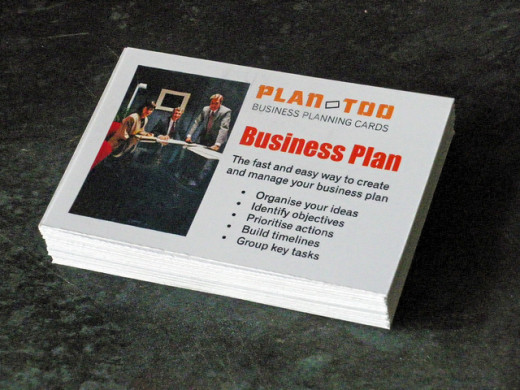Writing a Business Plan for Your Small Business
by Kathy Batesel

When Does an Entrepreneur Need a Business Plan?
When starting a new business, would-be entrepreneurs are instructed to draft a business plan. Many of them shrug off the task because they believe they have a sufficient plan already in mind or because they feel overwhelmed at doing the necessary research and writing to create one. They may not know exactly what a business plan is, or what it can do for them.
And it's BORING! It's much for fun to think about the possibilities and the success and how great things will be. Writing a business plan takes the fun and excitement and replaces it with reality, which is never as fun as our wildest fantasies, is it? Sadly, though, a good business is essential to making the very most of your business.
In my public relations studies, I learned how important they are and how to create them. I used my education to craft my own business plan when I became a Realtor. After I moved to another state, my new broker discovered that I could write business plans and hired me to help her draft commercial plans that enabled small business owners obtain financing to buy commercial real estate and fund their new business operations.
Because the vast majority of businesses fail during the first year, and a high percentage don't become profitable for several years, entrepreneurs should avoid sinking large sums of money into their new business without having a good idea of just how much profit or risk they're facing. Writing a business plan will help them see potential pitfalls and plan for them before they've signed an expensive commercial lease, purchased costly equipment, or devoted hours of time to no avail.
On the other hand, if you're planning to create a shoestring business that's not aimed at creating income, but simply something you want to do for pleasure (and that doesn't cost you an arm and a leg to keep going) you may be able to skip planning.
There's an old adage that says that in order to reach success, you should "plan your work, and then work your plan." Makes sense, doesn't it?
Are you thinking about or running a business now?
Benefits of a Good Business Plan
When you draft a business plan, you can slap it together with little thought or you can pay meticulous attention to research, detail, and tactics. The benefits you'll see from using it are only as good as the plan itself.
With an excellent business plan, you can:
- Use that fabled OPM - other people's money. Business loans, capital investments, and grant moneys won't come your way if you have a crappy business plan.
- Predict problems before they happen.
- Craft better strategies for gaining the biggest share of the market for which you're competing.
- Avoid unpleasant surprises about costs you'll face as your business develops.

Before You Begin Writing
A top-notch business plan - the kind that attracts investors - is one that proves you know everything you need to know about what you're doing. If you provide your business plan to an investor or lender, they are likely to turn you down if your planning hasn't addressed every single important factor they can imagine.
That means you need to research thoroughly. Although free online software and paid professionals can provide the structure and words for your document, it's still up to you to be the expert. I recommend using a free template to prompt you to think of individual items you may have overlooked, but many of the giveaway products available online are woefully incomplete. You'll have to add detailed information about each element that can affect your business:
- Your mission statement - a one or two sentence description of how your business will meet consumers' needs. Your mission statement should be simple, easy to understand, and general enough to allow for growth but specific enough to tell readers what the long-term purpose of your business is. Your purpose will be the same in twenty years as it is today, so think carefully about what needs you'll meet as times continue to change.
- A SWOT analysis - the strengths, weaknesses, opportunities, and threats your business will face. This step may involve some research, something I discuss in Research Your Business Plan.
- Projections - You'll need to have an idea of how much income your new business can generate. This step may seem overwhelming, especially if you haven't yet been operational. It may involve some guesswork, so it's especially important to be cautious here. Research on things like traffic counts for the area where you'll operating, online sales data for similar businesses, seasonal fluctuations, and factors that can boost or harm your sales can help you hone in on realistic figures.
- A cost analysis - realistic, accurate descriptions of every dime you will have to spend for your plan to be enacted. That means costs of equipment, details of payment plans you can take advantage of, labor costs you expect to pay, one-time and ongoing operating expenses, and overhead like property lease or purchase, electricity costs, or advertising. If you're counting on your cousing Joe to work on the cheap, that's great, but pretend he's a regular employee when it comes to your planning just to be on the safe side. Similarly, if you plan to use borrowed equipment or business space to save money, don't mention this in your plan. Instead, draft your plan as if you're paying for everything to avoid complications when unexpected difficulties arise. There are many free templates available from Microsoft to help you create many types of cost analyses.
Brief Sample of an Expense Cost Analysis
Expenses
| Jan.
| Feb.
| Mar.
| Total Q1
| April
| May
| June
| Q2
|
|---|---|---|---|---|---|---|---|---|
Rent
| $1,500
| $1,500
| $1,500
| $4,500
| $1,500
| $1,500
| $1,500
| $4,500
|
Labor
| $2,200
| $2,200
| $2,600
| $7,200
| $2,200
| $2,200
| $2,200
| $6,600
|
Electricity
| $250
| $250
| $200
| $700
| $200
| $200
| $275
| $675
|
Step By Step Help from Amazon


- Marketing plan (your target audience) - although your business plan's marketing section won't be as detailed as a strategic marketing plan, it will form the basis of your early efforts to generate customers. You'll need to focus on who you'll be targeting to do business with you, demonstrate that your target is likely to want to do business with you and why, describe how you will reach that audience, and how much it will cost to reach them. The "general public" is never a target audience! Consider which age groups will want your service or product, where you can find them, why they want what you're providing, and whether there's a specific arena where they'll congregate and be receptive to what you have to offer. (You'll find a few tips in the video below.)
- Market Plan (strategies and tactics) - You'll briefly describe channels that you'll use for communicating with them, whether that will be television advertising, radio blurbs, e-mail campaigns, direct mail, or other methods. Whichever methods you choose, you'll want to educate your business plan's readers on why that method is the most effective way to get your message to the target audience you've selected. Ideally, you'll find an arena and channel that makes it virtually impossible for your target audience to ignore what you're offering.
- Expertise - Your business plan should include information about the people who will be executing the plan, starting with you. Other key players who provide skills outside of your expertise should also be included, such as business partners, financial officers, or legal staff who are instrumental in making your plan work as you want it to. Each person should have a brief biography that shows that they are an ideal candidate for the tasks they'll be responsible for. Each bio should be brief, perhaps a paragraph, and include enough information to prove their abilities, but not more than is necessary.
- Executive summary - although it will appear at the front of your business plan, this is the final step to complete before putting all the information together into one document. Your executive summary shouldn't be more than two pages. It will tell people the basic information they'll find when they read the rest of your plan.
Helpful Products from Amazon
Assembling Your Business Plan
In the video above, you saw some general principles that are helpful to observe when preparing to write your business plan:
- Your plan should be 20-25 pages.
- The financial information will be critically important to investors you may approach.
- You will find yourself revising often as you hone in on certain segments and discover that something you hadn't considered before affects an aspect you already thought was prepared.
- It's important to have objective, concrete data rather than optimistic hopes.
Once you have completed each section of your business plan and made any necessary revisions, you'll be ready to assemble it in order. You may want to include some graphics, such as charts, tables, and calendars that help your business plan readers to envision your plan as thoroughly as you do. Small photos of people can accompany their biographic information, and you may have a logo you want to use. Avoid using too many pictures that distract readers, and stick to basic colors: white paper, black font, and minimal added colors.
You can use three-ring binders to assemble the pages and give you maximum flexibility if you find that you need to make revisions as you go. (I don't recommend hiring expensive printing to make a fancy book until you're certain that no more revisions will be needed!)
When you're done, a potential investor should be able to open your binder and see the following sections in this order:
- Table of Contents with page numbers
- Executive Summary
- Mission Statement
- SWOT Analysis
- Income Projections
- Costs Analysis
- Marketing Plan
- Bios
- Appendix (sources of information you've cited and additional relevant information)









